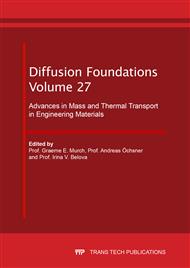p.3
p.25
p.35
p.40
p.50
p.63
p.73
p.90
Simulation of Intrinsic Defects and Cd Site Occupation in LaIn3 and LuIn3
Abstract:
In previous work, perturbed angular correlation spectroscopy (PAC) was used to determine jump rates of 111Cd, the daughter of the 111In radiotracer, in the series of phases RIn3 (R = rare-earth element) through nuclear quadrupole relaxation. Greater relaxation, indicating faster Cd jump rates, was observed in heavy rare-earths for compositions more deficient in indium, as would be expected for diffusion mediated by vacancies on the In sublattice. On the other hand, greater relaxation was observed for light rare-earths (R = La, Ce, and Pr) for compositions with excess indium, suggesting Cd diffusion is mediated there by a different mechanism. In this work, computer simulations were carried out to better understand the nature of the relaxation observed for the light rare-earths and the origin of the change in behavior across the rare-earth series. As a first step, formation enthalpies of intrinsic defects were calculated using density functional theory (DFT) for series end-members LaIn3 and LuIn3. Both compounds were found to exhibit Schottky thermal disorder. Additional DFT simulations show that the binding enthalpy between In-and R-vacancies is larger in LaIn3 than in LuIn3, suggesting that diffusion in LaIn3 might be mediated by divacancies. Site enthalpies of Cd also were calculated, and it was found more favorable energetically for Cd to occupy the In sublattice than the R sublattice in both end-member phases.
Info:
Periodical:
Pages:
40-49
Citation:
Online since:
May 2020
Authors:
Price:
Сopyright:
© 2020 Trans Tech Publications Ltd. All Rights Reserved
Share:
Citation:


